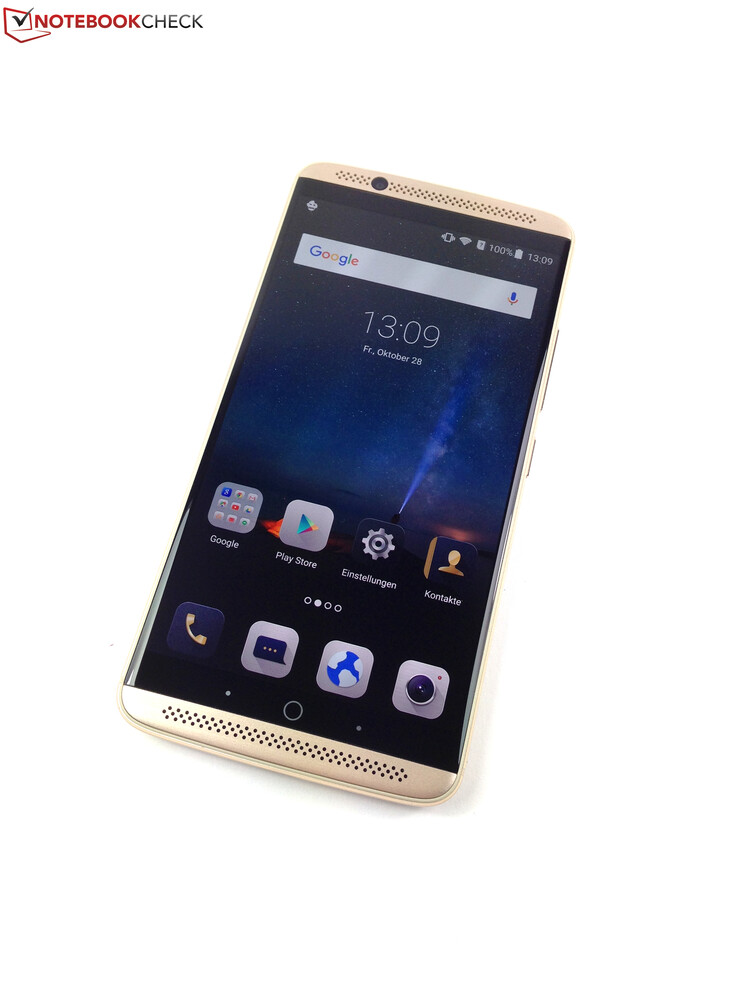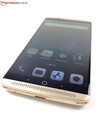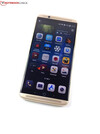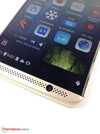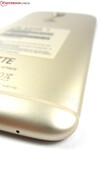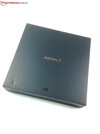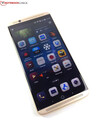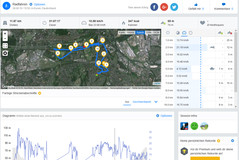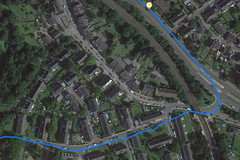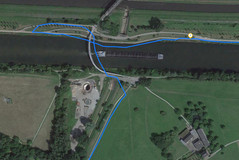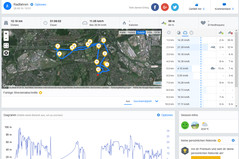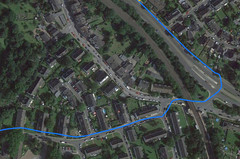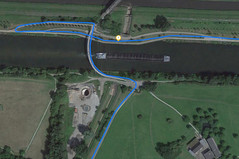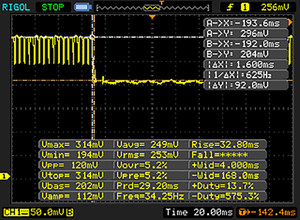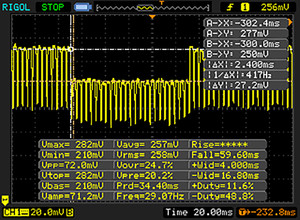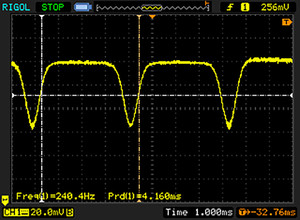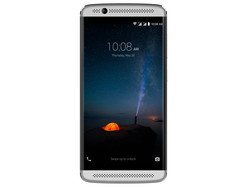Breve Análise do Smartphone ZTE Axon 7
Os Top 10
» Os Top 10 Portáteis Multimídia
» Os Top 10 Portáteis de Jogos
» Os Top 10 Portáteis Leves para Jogos
» Os Top 10 Portáteis Acessíveis de Escritório/Empresariais
» Os Top 10 Portáteis Premium de Escritório/Empresariais
» Os Top 10 dos Portáteis Workstation
» Os Top 10 Subportáteis
» Os Top 10 Ultrabooks
» Os Top 10 Conversíveis
» Os Top 10 Tablets
» Os Top 10 Smartphones
» A melhores Telas de Portáteis Analisadas Pela Notebookcheck
» Top 10 dos portáteis abaixo dos 500 Euros da Notebookcheck
» Top 10 dos Portáteis abaixo dos 300 Euros
Size Comparison
| Networking | |
| iperf3 transmit AX12 | |
| Samsung Galaxy S7 | |
| OnePlus 3 | |
| ZTE Axon 7 | |
| LG G5 | |
| Lenovo Moto Z Play | |
| Asus Zenfone 3 ZE552KL | |
| iperf3 receive AX12 | |
| ZTE Axon 7 | |
| OnePlus 3 | |
| Samsung Galaxy S7 | |
| LG G5 | |
| Lenovo Moto Z Play | |
| Asus Zenfone 3 ZE552KL | |
| |||||||||||||||||||||||||
iluminação: 88 %
iluminação com acumulador: 328 cd/m²
Contraste: ∞:1 (Preto: 0 cd/m²)
ΔE Color 4.6 | 0.5-29.43 Ø5
ΔE Greyscale 2.8 | 0.57-98 Ø5.3
Gamma: 2.29
| ZTE Axon 7 AMOLED, 2560x1440, 5.50 | Asus Zenfone 3 ZE552KL IPS, 1920x1080, 5.50 | OnePlus 3 Optic-AMOLED, 1920x1080, 5.50 | Lenovo Moto Z Play AMOLED, 1920x1080, 5.50 | Samsung Galaxy S7 SAMOLED, 2560x1440, 5.10 | LG G5 IPS Quantum, 2560x1440, 5.30 | HTC 10 Super LCD 5, 2560x1440, 5.20 | |
|---|---|---|---|---|---|---|---|
| Screen | 20% | 11% | 43% | 33% | 11% | 23% | |
| Brightness middle | 328 | 658 101% | 419 28% | 509 55% | 350 7% | 784 139% | 445 36% |
| Brightness | 334 | 633 90% | 431 29% | 511 53% | 351 5% | 774 132% | 434 30% |
| Brightness Distribution | 88 | 93 6% | 84 -5% | 93 6% | 98 11% | 91 3% | 93 6% |
| Black Level * | 0.66 | 0.43 | 0.36 | ||||
| Colorchecker dE 2000 * | 4.6 | 4.9 -7% | 4.1 11% | 2.2 52% | 2.04 56% | 6.5 -41% | 2.8 39% |
| Colorchecker dE 2000 max. * | 14.7 | 9.1 38% | 12 18% | 5.8 61% | 3.25 78% | 11.7 20% | 5.8 61% |
| Greyscale dE 2000 * | 2.8 | 5.8 -107% | 3.3 -18% | 2 29% | 1.63 42% | 8 -186% | 3.7 -32% |
| Gamma | 2.29 96% | 2.26 97% | 2.1 105% | 2.25 98% | 2.07 106% | 2.22 99% | 2.31 95% |
| CCT | 6612 98% | 7840 83% | 6550 99% | 6768 96% | 6391 102% | 8699 75% | 7164 91% |
| Contrast | 997 | 1823 | 1236 | ||||
| Color Space (Percent of AdobeRGB 1998) | 89.38 | 86.86 | 68.08 | ||||
| Color Space (Percent of sRGB) | 100 | 99.35 | 97.46 |
* ... smaller is better
Display Response Times
| ↔ Response Time Black to White | ||
|---|---|---|
| 3.2 ms ... rise ↗ and fall ↘ combined | ↗ 1.6 ms rise | |
| ↘ 1.6 ms fall | ||
| The screen shows very fast response rates in our tests and should be very well suited for fast-paced gaming. In comparison, all tested devices range from 0.1 (minimum) to 240 (maximum) ms. » 9 % of all devices are better. This means that the measured response time is better than the average of all tested devices (21.5 ms). | ||
| ↔ Response Time 50% Grey to 80% Grey | ||
| 4.8 ms ... rise ↗ and fall ↘ combined | ↗ 2.4 ms rise | |
| ↘ 2.4 ms fall | ||
| The screen shows very fast response rates in our tests and should be very well suited for fast-paced gaming. In comparison, all tested devices range from 0.2 (minimum) to 636 (maximum) ms. » 11 % of all devices are better. This means that the measured response time is better than the average of all tested devices (33.7 ms). | ||
Screen Flickering / PWM (Pulse-Width Modulation)
| Screen flickering / PWM detected | 240.4 Hz | ≤ 100 % brightness setting | |
The display backlight flickers at 240.4 Hz (worst case, e.g., utilizing PWM) Flickering detected at a brightness setting of 100 % and below. There should be no flickering or PWM above this brightness setting. The frequency of 240.4 Hz is relatively low, so sensitive users will likely notice flickering and experience eyestrain at the stated brightness setting and below. In comparison: 53 % of all tested devices do not use PWM to dim the display. If PWM was detected, an average of 17915 (minimum: 5 - maximum: 3846000) Hz was measured. | |||
| AnTuTu v6 - Total Score (sort by value) | |
| ZTE Axon 7 | |
| Asus Zenfone 3 ZE552KL | |
| OnePlus 3 | |
| Lenovo Moto Z Play | |
| Samsung Galaxy S7 | |
| LG G5 | |
| HTC 10 | |
| Geekbench 3 | |
| 64 Bit Single-Core Score (sort by value) | |
| OnePlus 3 | |
| Samsung Galaxy S7 | |
| LG G5 | |
| HTC 10 | |
| 64 Bit Multi-Core Score (sort by value) | |
| OnePlus 3 | |
| Samsung Galaxy S7 | |
| LG G5 | |
| HTC 10 | |
| 3DMark | |
| 1280x720 offscreen Ice Storm Unlimited Score (sort by value) | |
| ZTE Axon 7 | |
| Asus Zenfone 3 ZE552KL | |
| OnePlus 3 | |
| Lenovo Moto Z Play | |
| Samsung Galaxy S7 | |
| LG G5 | |
| HTC 10 | |
| 1280x720 offscreen Ice Storm Unlimited Graphics Score (sort by value) | |
| ZTE Axon 7 | |
| Asus Zenfone 3 ZE552KL | |
| OnePlus 3 | |
| Lenovo Moto Z Play | |
| Samsung Galaxy S7 | |
| LG G5 | |
| HTC 10 | |
| 1280x720 offscreen Ice Storm Unlimited Physics (sort by value) | |
| ZTE Axon 7 | |
| Asus Zenfone 3 ZE552KL | |
| OnePlus 3 | |
| Lenovo Moto Z Play | |
| Samsung Galaxy S7 | |
| LG G5 | |
| HTC 10 | |
| 2560x1440 Sling Shot OpenGL ES 3.0 (sort by value) | |
| ZTE Axon 7 | |
| Asus Zenfone 3 ZE552KL | |
| OnePlus 3 | |
| Lenovo Moto Z Play | |
| Samsung Galaxy S7 | |
| LG G5 | |
| HTC 10 | |
| 2560x1440 Sling Shot OpenGL ES 3.0 Graphics (sort by value) | |
| ZTE Axon 7 | |
| Asus Zenfone 3 ZE552KL | |
| OnePlus 3 | |
| Lenovo Moto Z Play | |
| Samsung Galaxy S7 | |
| LG G5 | |
| HTC 10 | |
| 2560x1440 Sling Shot OpenGL ES 3.0 Physics (sort by value) | |
| ZTE Axon 7 | |
| Asus Zenfone 3 ZE552KL | |
| OnePlus 3 | |
| Lenovo Moto Z Play | |
| Samsung Galaxy S7 | |
| LG G5 | |
| HTC 10 | |
| GFXBench (DX / GLBenchmark) 2.7 | |
| T-Rex Onscreen (sort by value) | |
| ZTE Axon 7 | |
| Asus Zenfone 3 ZE552KL | |
| OnePlus 3 | |
| Lenovo Moto Z Play | |
| Samsung Galaxy S7 | |
| LG G5 | |
| HTC 10 | |
| 1920x1080 T-Rex Offscreen (sort by value) | |
| ZTE Axon 7 | |
| Asus Zenfone 3 ZE552KL | |
| OnePlus 3 | |
| Lenovo Moto Z Play | |
| Samsung Galaxy S7 | |
| LG G5 | |
| HTC 10 | |
| GFXBench 3.0 | |
| on screen Manhattan Onscreen OGL (sort by value) | |
| ZTE Axon 7 | |
| Asus Zenfone 3 ZE552KL | |
| OnePlus 3 | |
| Lenovo Moto Z Play | |
| Samsung Galaxy S7 | |
| LG G5 | |
| HTC 10 | |
| 1920x1080 1080p Manhattan Offscreen (sort by value) | |
| ZTE Axon 7 | |
| Asus Zenfone 3 ZE552KL | |
| OnePlus 3 | |
| Lenovo Moto Z Play | |
| Samsung Galaxy S7 | |
| LG G5 | |
| HTC 10 | |
| GFXBench 3.1 | |
| on screen Manhattan ES 3.1 Onscreen (sort by value) | |
| ZTE Axon 7 | |
| Asus Zenfone 3 ZE552KL | |
| OnePlus 3 | |
| Lenovo Moto Z Play | |
| Samsung Galaxy S7 | |
| LG G5 | |
| HTC 10 | |
| 1920x1080 Manhattan ES 3.1 Offscreen (sort by value) | |
| ZTE Axon 7 | |
| Asus Zenfone 3 ZE552KL | |
| OnePlus 3 | |
| Lenovo Moto Z Play | |
| Samsung Galaxy S7 | |
| LG G5 | |
| HTC 10 | |
| PCMark for Android - Work performance score (sort by value) | |
| ZTE Axon 7 | |
| Asus Zenfone 3 ZE552KL | |
| OnePlus 3 | |
| Lenovo Moto Z Play | |
| Samsung Galaxy S7 | |
| LG G5 | |
| HTC 10 | |
| Octane V2 - Total Score (sort by value) | |
| ZTE Axon 7 | |
| Asus Zenfone 3 ZE552KL | |
| OnePlus 3 | |
| Lenovo Moto Z Play | |
| Samsung Galaxy S7 | |
| LG G5 | |
| HTC 10 | |
| Mozilla Kraken 1.1 - Total (sort by value) | |
| ZTE Axon 7 | |
| Asus Zenfone 3 ZE552KL | |
| OnePlus 3 | |
| Lenovo Moto Z Play | |
| Samsung Galaxy S7 | |
| LG G5 | |
| HTC 10 | |
| WebXPRT 2015 - Overall (sort by value) | |
| ZTE Axon 7 | |
| Asus Zenfone 3 ZE552KL | |
| OnePlus 3 | |
| Lenovo Moto Z Play | |
| Samsung Galaxy S7 | |
| LG G5 | |
| HTC 10 | |
| JetStream 1.1 - Total Score (sort by value) | |
| ZTE Axon 7 | |
| Asus Zenfone 3 ZE552KL | |
| OnePlus 3 | |
| Lenovo Moto Z Play | |
| Samsung Galaxy S7 | |
| LG G5 | |
| HTC 10 | |
* ... smaller is better
| ZTE Axon 7 | Huawei Honor 8 | Asus Zenfone 3 ZE552KL | OnePlus 3 | Lenovo Moto Z Play | Samsung Galaxy S7 | LG G5 | HTC 10 | |
|---|---|---|---|---|---|---|---|---|
| AndroBench 3-5 | -17% | 7% | 3% | -3% | -6% | -17% | ||
| Sequential Read 256KB SDCard | 78.4 | 79.2 1% | 74.6 -5% | 72.3 -8% | 78.5 0% | 83.3 6% | ||
| Sequential Write 256KB SDCard | 51.3 | 50.1 -2% | 50.6 -1% | 53.6 4% | 45.53 -11% | 65.4 27% | ||
| Sequential Read 256KB | 406.5 | 282 -31% | 408.7 1% | 254.8 -37% | 483.8 19% | 427.6 5% | 275.1 -32% | |
| Sequential Write 256KB | 150.9 | 188 25% | 153.3 2% | 73.1 -52% | 145.7 -3% | 141.3 -6% | 115.6 -23% | |
| Random Read 4KB | 121.1 | 74 -39% | 137.6 14% | 38.78 -68% | 85.9 -29% | 89.3 -26% | 29.92 -75% | |
| Random Write 4KB | 16.22 | 7.4 -54% | 18.23 12% | 45.58 181% | 16.01 -1% | 16.22 0% | 15.89 -2% |
| Asphalt 8: Airborne | |||
| Configurações | Valor | ||
| high | 29 fps | ||
| very low | 29 fps | ||
| Dead Trigger 2 | |||
| Configurações | Valor | ||
| high | 60 fps | ||
(+) The maximum temperature on the upper side is 39.5 °C / 103 F, compared to the average of 35 °C / 95 F, ranging from 21.9 to 56 °C for the class Smartphone.
(+) The bottom heats up to a maximum of 37.4 °C / 99 F, compared to the average of 33.8 °C / 93 F
(+) In idle usage, the average temperature for the upper side is 30.7 °C / 87 F, compared to the device average of 32.7 °C / 91 F.
ZTE Axon 7 audio analysis
(+) | speakers can play relatively loud (87.1 dB)
Bass 100 - 315 Hz
(-) | nearly no bass - on average 25.8% lower than median
(±) | linearity of bass is average (12.3% delta to prev. frequency)
Mids 400 - 2000 Hz
(±) | higher mids - on average 6% higher than median
(+) | mids are linear (4.6% delta to prev. frequency)
Highs 2 - 16 kHz
(±) | higher highs - on average 7.7% higher than median
(±) | linearity of highs is average (7% delta to prev. frequency)
Overall 100 - 16.000 Hz
(±) | linearity of overall sound is average (24.4% difference to median)
Compared to same class
» 52% of all tested devices in this class were better, 8% similar, 40% worse
» The best had a delta of 12%, average was 38%, worst was 134%
Compared to all devices tested
» 70% of all tested devices were better, 6% similar, 24% worse
» The best had a delta of 4%, average was 25%, worst was 134%
Samsung Galaxy S7 audio analysis
(+) | speakers can play relatively loud (87.4 dB)
Bass 100 - 315 Hz
(-) | nearly no bass - on average 25.2% lower than median
(±) | linearity of bass is average (9.2% delta to prev. frequency)
Mids 400 - 2000 Hz
(+) | balanced mids - only 4.1% away from median
(+) | mids are linear (5% delta to prev. frequency)
Highs 2 - 16 kHz
(±) | higher highs - on average 6.6% higher than median
(+) | highs are linear (6.3% delta to prev. frequency)
Overall 100 - 16.000 Hz
(±) | linearity of overall sound is average (20.9% difference to median)
Compared to same class
» 32% of all tested devices in this class were better, 8% similar, 60% worse
» The best had a delta of 12%, average was 38%, worst was 134%
Compared to all devices tested
» 52% of all tested devices were better, 8% similar, 41% worse
» The best had a delta of 4%, average was 25%, worst was 134%
LG G5 audio analysis
(+) | speakers can play relatively loud (86.4 dB)
Bass 100 - 315 Hz
(-) | nearly no bass - on average 28.3% lower than median
(±) | linearity of bass is average (12.5% delta to prev. frequency)
Mids 400 - 2000 Hz
(+) | balanced mids - only 3.6% away from median
(+) | mids are linear (4.3% delta to prev. frequency)
Highs 2 - 16 kHz
(+) | balanced highs - only 3.8% away from median
(+) | highs are linear (1.9% delta to prev. frequency)
Overall 100 - 16.000 Hz
(±) | linearity of overall sound is average (18.8% difference to median)
Compared to same class
» 16% of all tested devices in this class were better, 9% similar, 75% worse
» The best had a delta of 12%, average was 38%, worst was 134%
Compared to all devices tested
» 38% of all tested devices were better, 8% similar, 54% worse
» The best had a delta of 4%, average was 25%, worst was 134%
| desligado | |
| Ocioso | |
| Carga |
|
| ZTE Axon 7 3250 mAh | Asus Zenfone 3 ZE552KL 3000 mAh | OnePlus 3 3000 mAh | Lenovo Moto Z Play 3510 mAh | Samsung Galaxy S7 3000 mAh | LG G5 2800 mAh | HTC 10 3000 mAh | |
|---|---|---|---|---|---|---|---|
| Power Consumption | -47% | -18% | 29% | -1% | -40% | -44% | |
| Idle Minimum * | 0.64 | 0.83 -30% | 0.57 11% | 0.51 20% | 0.68 -6% | 0.55 14% | 0.68 -6% |
| Idle Average * | 0.84 | 2.11 -151% | 1.24 -48% | 0.87 -4% | 1.02 -21% | 1.37 -63% | 1.49 -77% |
| Idle Maximum * | 0.87 | 2.12 -144% | 1.36 -56% | 0.9 -3% | 1.14 -31% | 2.25 -159% | 1.91 -120% |
| Load Average * | 6.02 | 3.41 43% | 5.92 2% | 1.69 72% | 4.73 21% | 6.24 -4% | 7.4 -23% |
| Load Maximum * | 10.45 | 5.46 48% | 10.53 -1% | 4 62% | 7.16 31% | 9.12 13% | 9.71 7% |
* ... smaller is better
| ZTE Axon 7 3250 mAh | Asus Zenfone 3 ZE552KL 3000 mAh | OnePlus 3 3000 mAh | Lenovo Moto Z Play 3510 mAh | Samsung Galaxy S7 3000 mAh | LG G5 2800 mAh | HTC 10 3000 mAh | |
|---|---|---|---|---|---|---|---|
| Battery Runtime | 39% | 28% | 95% | 10% | -2% | -13% | |
| Reader / Idle | 1735 | 1502 -13% | 1338 -23% | 2540 46% | 1810 4% | 1833 6% | 1273 -27% |
| H.264 | 704 | 905 29% | 847 20% | 1190 69% | 892 27% | 600 -15% | 648 -8% |
| WiFi v1.3 | 411 | 797 94% | 840 104% | 824 100% | 456 11% | 387 -6% | 413 0% |
| Load | 245 | 352 44% | 268 9% | 652 166% | 242 -1% | 267 9% | 203 -17% |
Pro
Contra
A ZTE não prometeu muito: O Axon 7 se enfrenta com facilidades a smartphones de gama superior, como o Samsung Galaxy S7 mesmo que em última instância, não consiga chegar ao nível desses aparelhos. O smartphone ZTE não possui o recurso final para isto - uma veloz porta USB, armazenamento interno maior, e carregamento sem fio, teriam resultado em um pontuação um pouco mais alta. No entanto, isto não diminui a excelente configuração e o pacote de desempenho que o usuário recebe com o Axon 7.
O ZTE Axon 7 não é apenas um digno oponente para smartphones de gama alta como o Samsung Galaxy S7, ele também convence com um excelente som Dolby surround.
Gostamos particularmente da carcaça de alta qualidade, painel QHD nítido, muito bom módulo de câmera e o desempenho mais que suficiente para cada smartphone na situação de teste. E qualquer um à procura de um smartphone com um som realmente bom, terá que optar pelo ZTE Axon 7 porque acusticamente ele supera seus rivais, e por muito, com o seu som Dolby-Atmos.
O ZTE Axon 7 também deve aceitar algumas críticas, embora não haja muito o que criticar. Alguns usuários podem não gostar do visual da interface MiFavor 4.0 - mas o visual pode ser modificado para que seja quase igual ao do Android padrão, mediante uma app. Uma porta USB mais veloz teria combinado bem com o Axon 7, bem como uma duração de bateria um pouco melhor e uma bateria removível.
ZTE Axon 7
-
10/31/2016 v5.1(old)
Manuel Masiero


 Deutsch
Deutsch English
English Español
Español Français
Français Italiano
Italiano Nederlands
Nederlands Polski
Polski Português
Português Русский
Русский Türkçe
Türkçe Svenska
Svenska Chinese
Chinese Magyar
Magyar